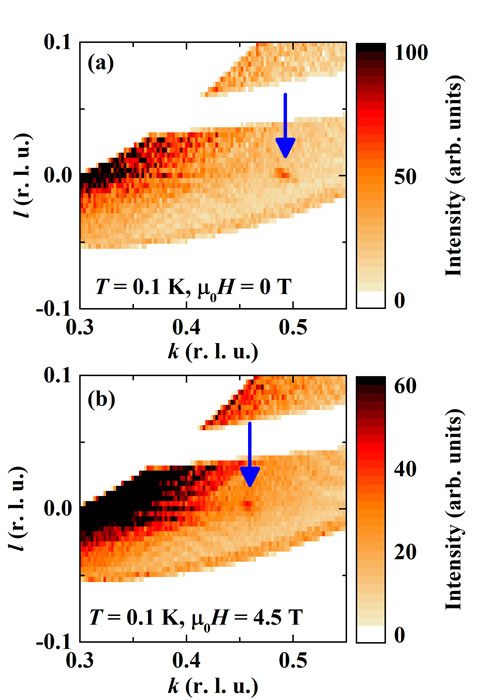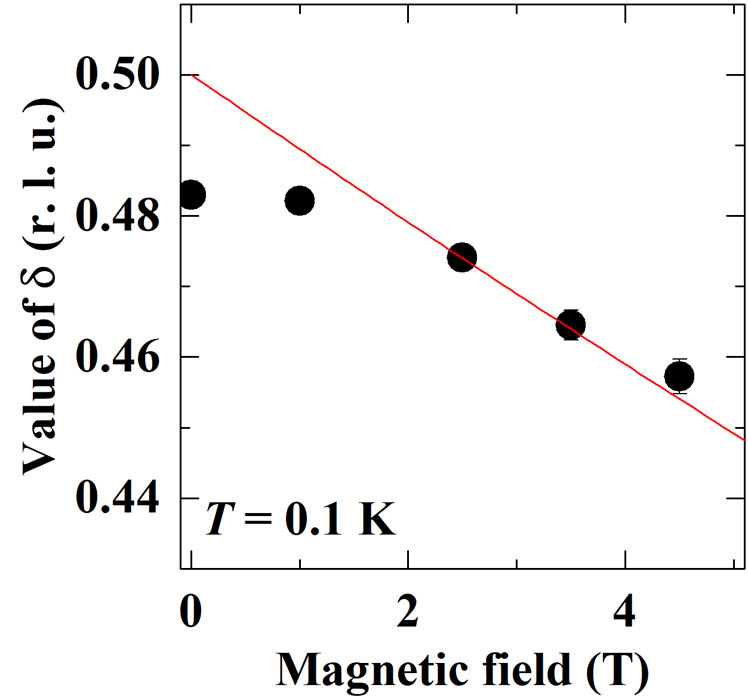Spin Density Wave Induced by Bound Two-Magnon in S = 1/2 Frustrated Chain Compound NaCuMoO4(OH)
Masuda Group
Frustrated magnetism has attracted great attention because of nontrivial phases induced by the lift of macroscopic degeneracy. One of the interesting examples is found in S = 1/2 one-dimensional spin system with nearest-neighbor ferromagnetic and next-nearest-neighbor antiferromagnetic interactions [1]. A theory predicts that a bound two-magnon in high magnetic field induces exotic phases characterized by the spin-density-wave (SDW) and spin multipole correlations in the frustrated ferromagnetic chain [2]. So far, these states have not been fully investigated by spectroscopic method because of high saturation field and/or difficulty of obtaining a large single crystal for existing model compounds. NaCuMoO4(OH) is an experimental realization of the system having decent energy scale, saturation field of 26 T [3] which is available on the pulse magnet for neutron scattering [4]. The synthesis of a single crystal was reported [5]. The NMR and heat capacity study suggest a magnetic transition at Hc of 1.5 - 1.8 T [3]. For the full identification of the magnetic states in zero and finite fields neutron diffraction technique is indispensable. We hereby report the magnetic structure analysis by using the time-of-flight neutron diffractometer SENJU installed at J-PARC [6] on a single crystal NaCuMoO4(OH).
Figure 1(a) and 1(b) shows the contour maps of neutron intensities in the (0kl) plane around the reciprocal lattice point (0, δ, 0) at 0.1 K under the magnetic field of (a) 0 and (b) 4.5 T. We found that the peak indicated by the blue arrow in Fig. 1(a) appear at (0, δ, 0) (δ ~ 0.48) below the transition temperature of 0.6 K. It means that the peak comes from the magnetic origin. We further found peaks at (1δ1) and (0δ2). Magnetic structure analysis reveals that the proper-screw structure with the ferromagnetic interchain coupling with the propagation vector of (0, δ, 0) is realized at zero field. Furthermore, we found that the magnetic peak at (0δ0) was shifted to smaller k direction by applying a magnetic field as shown in Fig. 1(b). This behavior suggests that the field induces SDW state, in which the density correlation of bound magnon is developed and its incommensurability is represented in terms of magnetization. In Fig. 2 the value of δ is independent of the field below Hc, and it decreases with increasing the field above Hc. The negative slope of the line above Hc indicated by red line is consistent with the theoretical prediction for the SDW2 state [7]. The result demonstrates that the bound two-magnon leads to the SDW state in high magnetic field in the compound.
References
- [1] S. Furukawa, M. Sato, and S. Onoda, Phys. Rev. Lett. 105, 257205 (2010).
- [2] T. Hikihara, L. Kecke, T. Momoi, and A. Furusaki, Phys. Rev. B 78, 144404 (2008).
- [3] K. Nawa, Y. Okamoto, A. Matsuo, K. Kindo, Y. Kitahara, S. Yoshida, S. Ikeda, S. Hara, T. Sakurai, S. Okubo, H. Ohta, and Z. Hiroi, J. Phys. Soc. Jpn. 83, 103702 (2014).
- [4] H. Nojiri, S. Yoshii, M. Yasui, K. Okada, M. Matsuda, J. -S. Jung, T. Kimura, L. Santodonato, G. E. Granroth, K. A. Ross, J. P. Carlo, and B. D. Gaulin, Phys. Rev. Lett. 106, 237202 (2011).
- [5] K. Nawa, Y. Okamoto, and Z. Hiroi, J. Phys.: Conf. Ser. 828, 012005 (2017).
- [6] T. Ohhara, R. Kiyanagi, K. Oikawa, K. Kaneko, T. Kawasaki, I. Tamura, A. Nakao, T. Hanashima, K.Munakata, T. Moyoshi, T. Kuroda, H. Kimura, T. Sakakura, C.-H. Lee, M. Takahashi, K.-i. Ohshima, T. Kiyotani, Y. Noda, and M. Arai, J. Appl. Cryst. 49, 120 (2016).
- [7]. M. Sato, T. Momoi, and A. Furusaki, Phys. Rev. B 79, 060406(R) (2009).


